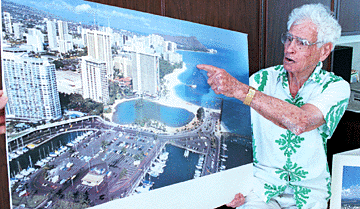



"I would like to see water transportation for $1 a trip, just like the bus," he said. "You could charge tourists more, maybe $5 or $6."
Conrad, 87, has explained his dream to many people over the past two years, including state and city transportation directors and political leaders.
"We sat down last November with Kazu Hayashida (state transportation director) and the division chiefs for harbors, airports and highways," Conrad said. "We've also talked to Mayor Jeremy Harris and Bob Fishman, the city's managing director, and Chuck Swanson, the former city transportation director. So far, everyone seems to like the idea."
Conrad also has talked to many state legislators using visual props to sell is his idea. He took aerial photographs of the Waikiki shoreline and blew them up to three- and four-foot-long displays "to give them the visual impact" of the ocean trip experience.
Conrad, who also was an architect and planner, would like at least three docking facilities serving Waikiki: the first one at the Waikiki side of Magic Island, along with the Ala Wai boat harbor; at the Hilton Hawaiian Village; and also at Ft. DeRussy. Others could be located at the Natatorium in Waikiki and the Aloha Tower Marketplace in Honolulu Harbor, he said.
"There is 3,000 lineal feet along Magic Island park which can take five boats," Conrad said. "And there is another 3,000 lineal feet if we clean up the harbor and take out the repair facility. That area could take three more boats."
The eight boats could take 2,000 passengers to Waikiki and another 2,000 on the return trip to the airport, he said.
The state is interested in the ferry idea. "We're talking to airports," said Rick Egged, planning director at the Department of Business, Economic Development and Tourism. "They would like to include it in their master plan."
The airport must be able to handle baggage, Egged said. "We're in the early stages of considering the best way to do this," he added. But there is no doubt about the need. "Ala Moana boulevard traffic projections don't look good," he said.
But how much would all this cost and how would it be financed?
Conrad said all of the numbers haven't been crunched but added: "The cost is not that much when you consider the alternative" of the adverse effect to tourism from mounting traffic congestion. "We have to keep improving our tourist facilities or they won't come here. And what a wonderful way to come from the airport to the hotels -- over water."
Conrad said he already has identified a ship-building company in Washington that has 97-foot-long catamarans (with a shallow-draft of only three feet) capable of carrying 250 people. He thinks eight of these ships, at $3.8 million each, would be a good start.
The catamarans from Nichols Brothers in Seattle are used in Alameda, Calif., Washington state, and other cities.
But catamarans are only one possibility. Conrad and architect/planner Andrew Yanoviak have talked to Steven Louie, president of Pacific Marine & Supply Co., about another type of ship design that could work. Pacific Marine, the builder of Navatek ships, said it might be able to modify a ship design for an airport-Waikiki trip.
Conrad is a familiar, smiling face to the public from his television commercials pitching Conrad Jewelers and Security Diamond.
He talks with rapid-fire enthusiasm about Waikiki and such options as full-time use of a catamaran just to make the short trip in the Ala Wai canal between the Ala Moana and Kalakaua bridges and drop off people at the Hawaii Convention Center.
(E. Alvey Wright, former state transportation director, has been pitching a different plan that calls for only one docking facility in Waikiki, at the Ala Wai boat harbor. A barge would take people on the Ala Wai canal to the convention center. A shuttle would take tourists to Waikiki hotels.)
Conrad isn't slowing down at all. He has talked to the Hawaii Convention Center Authority, Ala Moana Center, Richard Kelley, chairman of Outrigger Hotels & Resorts, and Don Goo, the architect for Hilton Hawaiian Village.
Conrad arrived in Hawaii during the Great Depression with only $15 and got to know hotel developer Roy Kelley, who then was working as an architect for the famous Charles Dickey. Kelley got him a job with the Dickey firm. Conrad later worked for architect Harry Bent and then formed the firm Dahl and Conrad in 1936.
But construction stopped during World War II and Conrad turned to the jewelry business, running his father's Security Diamond shop at Nuuanu Avenue and Pauahi Street.
"My dad told me how to be a jeweler in 10 days and that was it," Conrad said.
At its height, Security Diamond and Conrad Jewelers did more than $10 million in business a year and employed 150 workers.
Conrad retired in 1979, but retains the zeal for business. Now his pet project is the ferry and Conrad will give a 30-minute pep talk at any opportunity.
"It's time to get down to brass tacks and do something," he said.